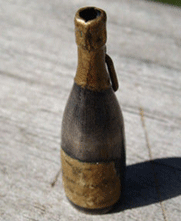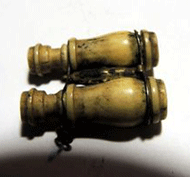|
These notable and at least somewhat famous items are Stanhopes or Stanhope Viewers, which are used to see microphotographs. We have all looked into some version of these mini-viewing devices during our lives and seen some faraway place, national monument or point of interest. Few realize they were invented in the mid-1800s.
|

|

|
|
A Stanhope Viewer in the shape of a champagne bottle. (Photo: Gary Robinson, eBay seller The-Imperial-Restaurant.)
|
Stanhope binoculars.
(Photo: eBay seller Melsposhjunk.)
|
The invention of the Stanhope Viewer is credited to Rene Dagron (Mar. 17, 1819-June 13, 1900) while living in Paris. You notice that his invention does not bear his name. Stanhopes are so called because Dagron implemented part of a microscope lens system invented by Charles Stanhope, the 3rd Earl of Stanhope (Aug. 3, 1753-Dec. 15, 1816). Stanhope created a miniature microscope which was basically a short tube with convex lenses on either ends, one more convex than the other. Stanhope was a scientist, and his invention was a carry-in-your-pocket-all-the-time microscope. In addition to its convenient size, it was much less expensive than a magnifying glass.
Dagron had a daguerreotype business, and when he saw microfilm first exhibited in Paris, he hit on the idea of making these small, novelty viewers. His version used Stanhope lenses, but instead of two convex lenses, Dagron’s invention had one convex and one flat lens.
Dagron obtained a patent for microphotography in 1859,1 and he contributed his talent for microphotography to France’s war effort during the Franco-Prussian War, specifically during the Siege of Paris (Sept. 19, 1870- Jan. 28, 1871). Dagron convinced the French government that he could communicate information to their allies outside the city by photographing newspapers and other information in miniature form and “mailing” it on carrier pigeons. Upon receiving the microfilm, a magic lantern projected the image which was transcribed and passed along. The government hired Dagron, and he successfully transported more than 100,000 microphotography images. France, however, lost the siege and was defeated by the Prussians.
Stanhopes come in almost every shape imaginable, from the champagne bottle and binoculars shown here to miniature bibles, hats, rings, necklaces, pipes, scissors, mourning pendants, charms (in every shape from phonographs to trolley cars), lighters, pens, thimble holders, crosses, in the clasps of knives, TV sets, miniature barrels (Niagara Falls souvenirs) and of course, the oblong rectangular shapes most often seen.
Stanhopes’ values are across the spectrum from a couple of dollars to a few hundred. In 2014, a Victorian stickpin with a purple paste-glass hand holding a small, tube-shaped Stanhope Viewer made of 10k gold sold for $351 on eBay. An ivory or bone needle case carved in the shape of a fish sold for $182, and a 2-5/8 inch perfume bottle in the shape of a seltzer bottle sold for $202, both on eBay.
Dagron invented the Stanhope Viewer in about 1858, and it has been famous ever since.
------------------------------
1
University of California Southern Regional Library System, www.srlf.ucla.edu/exhibit/text/hist_page3.htm.
|